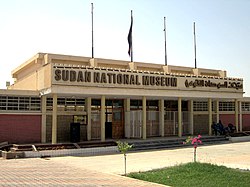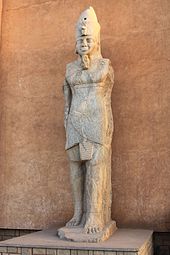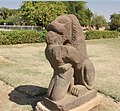National Museum of Sudan
 Main entrance to the Sudan National Museum |
|
| Data | |
|---|---|
| place | El Neel Avenue, Khartoum |
| Art |
Archaeological collection of different periods in the history of Sudan
|
| opening | 1971 |
| Website | |
The National Museum of Sudan ( Arabic متحف السودان القومي, DMG Matḥaf as-Sudan al-qaumi ) in Khartoum houses the largest collection on the history of Sudan .
It contains works from different epochs of Sudan's cultural history: Paleolithic , Mesolithic , Neolithic , A-group culture , C-group culture , Kerma culture , Middle Kingdom , New Kingdom , Kingdom of Kush , Ballana , Makuria and Nubia in the Middle Ages .
The construction of the museum lasted from 1964 to 1971. It is located on El-Neel-Allee in Khartoum not far from the confluence of the Blue and White Nile .
Creation of the collection
The first antiquities law of the British administration of Anglo-Egyptian Sudan came into being in 1905. The antiquities administration of Sudan, today the "National Corporation for Antiquities and Museums", is assigned to the Ministry of Environment and Tourism. In addition to supervising excavations and restorations in the country, it is also responsible for the Sudanese museums.
The antiquities law required the excavators to divide the finds . The resulting collection in the course of time was first exhibited in the former English officers' mess after various other stops. After Sudan's independence in 1956, a new museum building was finally planned. As a result of the construction of the Aswan Dam from 1960, the reservoir of which extends far into Sudan, the collection experienced great growth, because numerous archaeological expeditions were working in the flood-threatened areas. A number of Nubian temples were dismantled and brought to Khartoum in pieces. After many years of work on rebuilding the temple, the museum was opened on May 28, 1971. The museum's collection is constantly growing due to current excavations. It currently comprises over 30,000 individual items.
The main pieces in the collection
The museum park
The rebuilt temples from the floodplain of Lake Nasser
In the museum park, the temples dismantled in Nubia were rebuilt according to their old orientation. They are now grouped around an elongated water basin designed by Friedrich Hinkel , which symbolizes the Nile . For weather protection reasons, they are located in pavilions that can be pushed back in the dry season .
- A victory inscription from Pharaoh Djer from the 1st dynasty by the Gebel Sheikh Suliman
- The Temple of Horus from the Buhen fortress built by Hatshepsut
- The Khnum Temple from the Kumma Fortress
- The temple from the Semna fortress , Sesostris III. and dedicated to Dedwen
- A wall of of Ramses II. Built Aksha temple , himself and Amun consecrated
- The rock tomb of Prince Djehuti-Hotep from Dibeira
- Granite columns from Faras Cathedral
Kumma Temple: Khnum with a ram's head (left) and Tuthmosis III (center) with a lapwing in his hand moving towards Hathor (right)
Semna Temple: A drawing from the New Kingdom shows Sesostris III on a ship
More pieces
- 6 lion statues from Basa
- 2 frog statues from Basa
- 2 ram statues from Kawa
- 2 colossal statues, seven meters high and weighing 30 tons, from the temple in Tabo
Museum building
ground floor
In addition to many smaller pieces, the following large objects can be seen in the museum:
- Black and red fired ceramics from the C-group culture
- Statues of the pharaohs Sobekhotep III. , Sesostris III. and Taharqa
- A colossal statue and altar of the Nubian king Atlanersa
- A sphinx and a sacrificial stone from the Senkamanisk
- The granite sarcophagus and a statue of Anlamani
- A sacrificial stone, a stele and a sacrificial vase of Siaspi-qo
- Stela of Amenemhat
- A bow-legged figure of the dwarf goddess Beset
Mural from Faras Cathedral
First floor
Several medieval wall paintings from Faras Cathedral .
literature
- Friedrich W. Hinkel: Excerpt from Nubia . Akademie-Verlag, Berlin 1978.
- Heinrich Fendel, Rainer Fischer, Joachim Maaß: Grave steles in the National Museum Khartoum - Lower Saxon restorers in Sudan. In: Hans-Herbert Möller (Ed.): Restoration of cultural monuments. Examples from the preservation of historical monuments in Lower Saxony (= reports on historical preservation. Supplement 2). Lower Saxony State Administration Office - Institute for Monument Preservation / Niemeyer, Hameln 1989, ISBN 3-87585-152-8 , pp. 63–67
- Dietrich Wildung : Sudan - Ancient Kingdoms on the Nile . Wasmuth, Tübingen 1998, ISBN 3-8030-3084-6 .
Web links
- English travel description of the museum
- The Sudan National Museum in Khartoum. An Illustrated Guide for Visitors. (accessed on March 8, 2017)
Individual evidence
- ^ Sudan National Museum. Retrieved November 18, 2019 .
- ^ Friedrich W. Hinkel: Report on the dismantling and removal of endangered monuments in Sudanese Nubia, 1962-63. In: Kush: Journal of the Sudan Antiquities Service. Volume 12, 1964, pp. 111-118.










